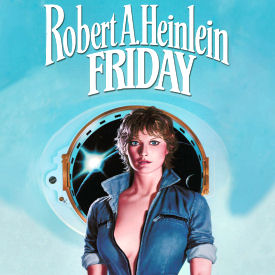
As I left the Kenya Beanstalk capsule he was right on my heels. He followed me through the door leading to Customs, Health, and Immigration. As the door contracted behind him I killed him. (From Friday, by Robert A. Heinlein.) For a long-time SF reader, I don’t think there could be a more science-fictional opening paragraph for a book than that one. Think about it: Kenya Beanstalk—implying a technology more advanced than today’s; the door “contracted,” implying an iris-type doorway; and she killed him without knowing anything more than that he was following her—which implies several things, all of them exciting. Is she a spy? A government agent? Who and what is “he,” and why did he deserve killing? Und so weiter. That sentence hooked me on the book, and it—the action–pretty much didn’t let up until the end of the book. This sort of thing is why I first started reading SF, and why I read and still read action/adventure non-SF books, like detective fiction, Westerns, and horror; and also a certain amount of non-fiction that gave/gives me an insight into the underpinnings of our world. I craved (and still do) excitement; something the mundane world, the quotidian world—especially when I was a youngster—didn’t offer. So I kept reading Heinlein and other terrific SF/F writers. I learned, as did most of us, that we weren’t going to get all that was promised—I still don’t have my jet pack or flying car—and were forced to scale down our day-to-day dreams, but in SF/F, we could have it all.

The following quote from Heinlein’s book Glory Road says what I would like to have said:
What did I want?
I wanted a Roc’s egg. I wanted a harem loaded with lovely odalisques less than the dust beneath my chariot wheels, the rust that never stained my sword. I wanted raw red gold in nuggets the size of your fist and feed that lousy claim jumper to the huskies! I wanted to get up feeling brisk and go out and break some lances, Then pick a likely wench for my droit du seigneur—I wanted to stand up to the Baron and dare him to touch my wench! I wanted to hear the purple water chuckling against the skin of the Nancy Lee in the cool of the morning watch and not another sound, nor any movement save the slow tilling of the wings of the albatross that had been pacing us the last thousand miles.
I wanted the hurtling moons of Barsoom. I wanted Storisende and Poictesme, and Holmes shaking me awake to tell me, “The game’s afoot!” I wanted to float down the Mississippi on a raft and elude a mob in company with the Duke of Bilgewater and the Lost Dauphin.
I wanted Prester John, and Excalibur held by a moon-white arm out of a silent lake. I wanted to sail with Ulysses and with Tros of Samothrace and eat the lotus in a land that seemed always afternoon. I wanted the feeling of romance and the sense of wonder I had known as a kid. I wanted the world to be what they had promised me it was going to be…. (From Glory Road, by Robert A. Heinlein.)

Yet there are things in RAH’s work that bother me to some extent. For one, some of his attitudes about nudity and sex, as expressed in his books, seem juvenile or are non-mainstream. (For example, he appears to have some kind of fetish about spanking—that is, if you believe that things expressed in more than one book have a very good chance of representing the author’s P.O.V. In, for example, The Cat Who Walks Through Walls, the protagonist [Richard Ames or Colin Campbell—a lot of his characters in later books change names as often as they change coats] expresses a desire to “paddle the bottom” of a 15-year-old blonde named Gretchen “until it turns pink.” And in Glory Road, Oscar Gordon tells his soon-to-be wife, Star [the Empress of Twenty Systems, we’re told] that if she ever talks—or talks back—to him again the way she just did at one point, he’d spank her for it. Maybe I’m sheltered—I’ve never had a sexual partner who enjoyed that sort of sex play, although according to Kinsey [or Krafft-Ebing], it’s a fairly common thing.)

And in The Number of the Beast, there is enough wrangling about getting naked to fill—I swear, though I haven’t read it for years—a quarter of the book. (Another quarter was filled with arguing about who was in charge!) I may have forgotten some, but the first time I noticed nudity in a Heinlein book was in The Door Into Summer, where the protagonist pops into a nudist colony near Denver, I believe. And there is a lot of nudity- or sex-related talk in other books (I Will Fear No Evil, I’m talkin’ ’bout you!) So possibly, this is all related to his being born before 1910 and not being allowed to discuss sex at all in his writing before 1961, when Stranger in a Strange Land was published. And from that book on, sex and nudity are seldom far from the surface of a Heinlein book.

According to writer Michael Arbeiter, on mentalfloss.com, Heinlein said (when asked to tone down the sex and religion in Stranger): “This story is supposed to be a completely free-wheeling look at contemporary human culture from the nonhuman viewpoint of the Man from Mars (in the sense of the philosophical cliche)…No sacred cows of any sort…But, in addition to a double dozen of minor satirical slants, the two major things which I am attacking are the two biggest, fattest sacred cows of all, the two that every writer is supposed to give at least lip service to: the implicit assumptions of our Western culture concerning religion and concerning sex.”
But there has been a lot of sex and religion in SF/F—particularly beginning with—let’s say for argument’s sake—Theodore Sturgeon, with “Some of your blood,” which was a subtle sexual twist on a vampire story (and before that, there was supposedly a bit of a competition to sneak something sex-related past John W. Campbell’s assistant Kay Tarrant, which was won by someone like Cleve Cartmill by submitting a story concerning a “ball-bearing mousetrap”—probably an apocryphal story—which was actually a tomcat. Mike Ashley, in his History of the Science Fiction Magazines (Vol. III), claims that Campbell used Tarrant’s name as an excuse; he was actually the one who kept out mentions of sex. We can’t forget that James Blish “did” religion in A Case of Conscience, following that book up with Black Easter, which involved demons and Hell. Philip José Farmer, with The Lovers, brought sex to the fore in SF, and satirized SF, sex and popular culture with “Riders of the Purple Wage.” But in my opinion, Heinlein’s exploration of both sex and religion had a sort of stilted, juvenile way about it.
But Heinlein, at his most didactic, could teach as well as entertain without slapping you in the face and saying “Hey! I’m telling you something important here!” All his “juveniles,” to some degree, involved an older person (usually male) teaching a younger person (usually male) important things about life, the Universe and… well, you know what I mean. And since I grew up reading those juveniles at nearly the time they were released, I absorbed a lot of Heinlein into myself. In an attempt to resolve, to my own satisfaction, whether I had learned the “right” things from reading him, I’ve been rereading (in some cases, for the first time since they were released) much of Heinlein’s work. And asking myself “Are these books still readable and relevant?” Well, I think so. The boring parts—the juvenile sex talk, and the wrangling over who’s on first… I mean, in charge—of, for example, The Number of the Beast, are actually subsumed in a romp through time, space and dimension; and that book serves as an extra intro to his “world as myth” idea, which was explored in The Cat Who Walks Through Walls and others. Although in his later books RAH used characters from other authors (E.E. “Doc” Smith, L. Frank Baum, etc.), his writing was not derivative of others’ work, remaining original—at least in my opinion—right up to the end. And there is a lot of derivative work being published these days, especially in ebooks.
Speaking of trying to divine an author’s likes and dislikes through his (or her) writing, we will talk some time later about some of the Heinlein works that have been controversial for various reasons—books like Starship Troopers and Farnham’s Freehold.
If you can, please comment on this column. If you haven’t already registered, please register and comment here. Or you can comment on my Facebook page, or in the several Facebook groups where I publish a link to this column. Your comments are all welcome. Please don’t feel you have to agree with me to post a comment; my opinion is, as always, my own, and doesn’t necessarily reflect the views of Amazing Stories or its owners, editors, publishers or other columnists. See you next week!











Heinlein was a nudist. Even when he was a boy.
Hey, I would be too. But I don’t want people to avert their eyes all the time. 🙂